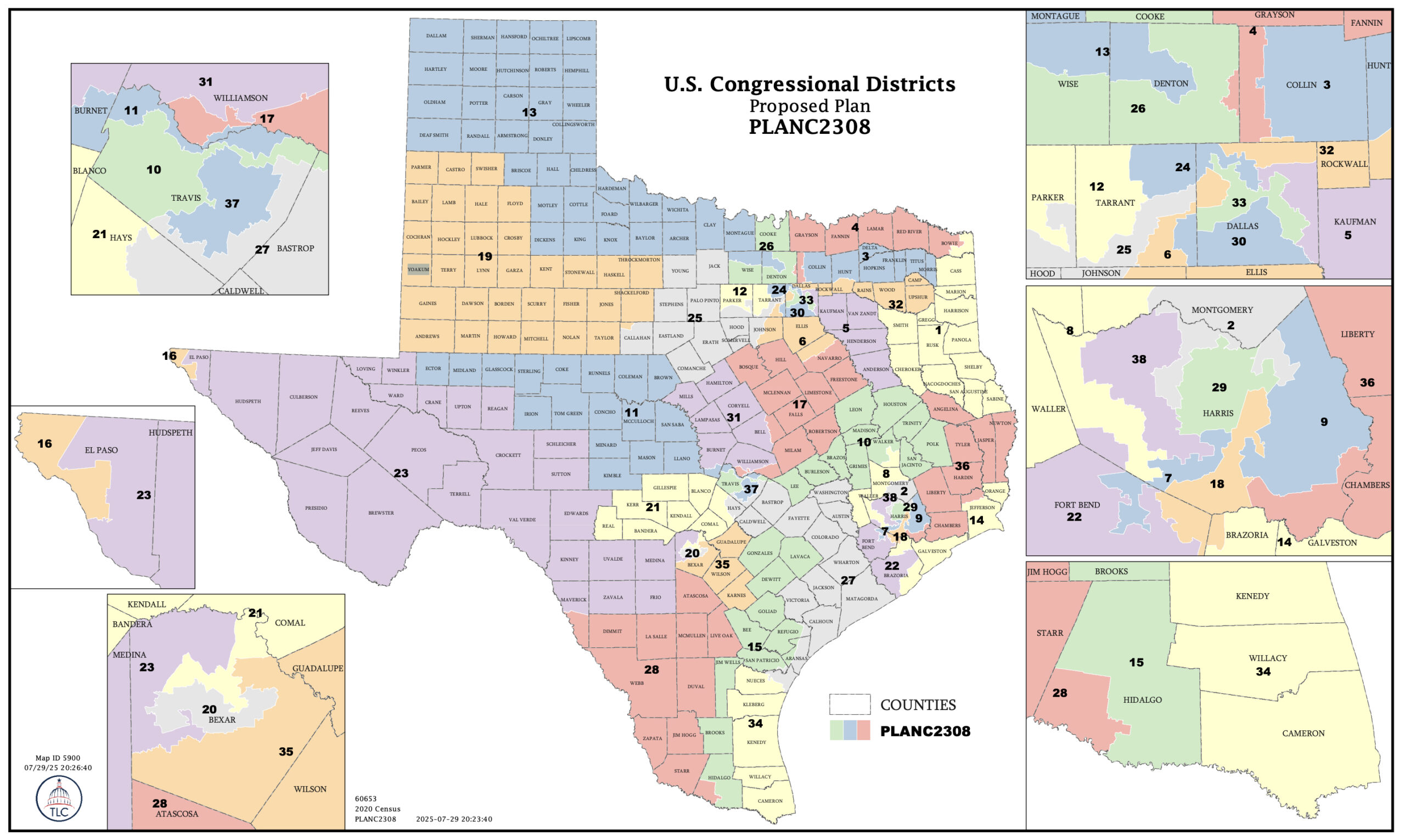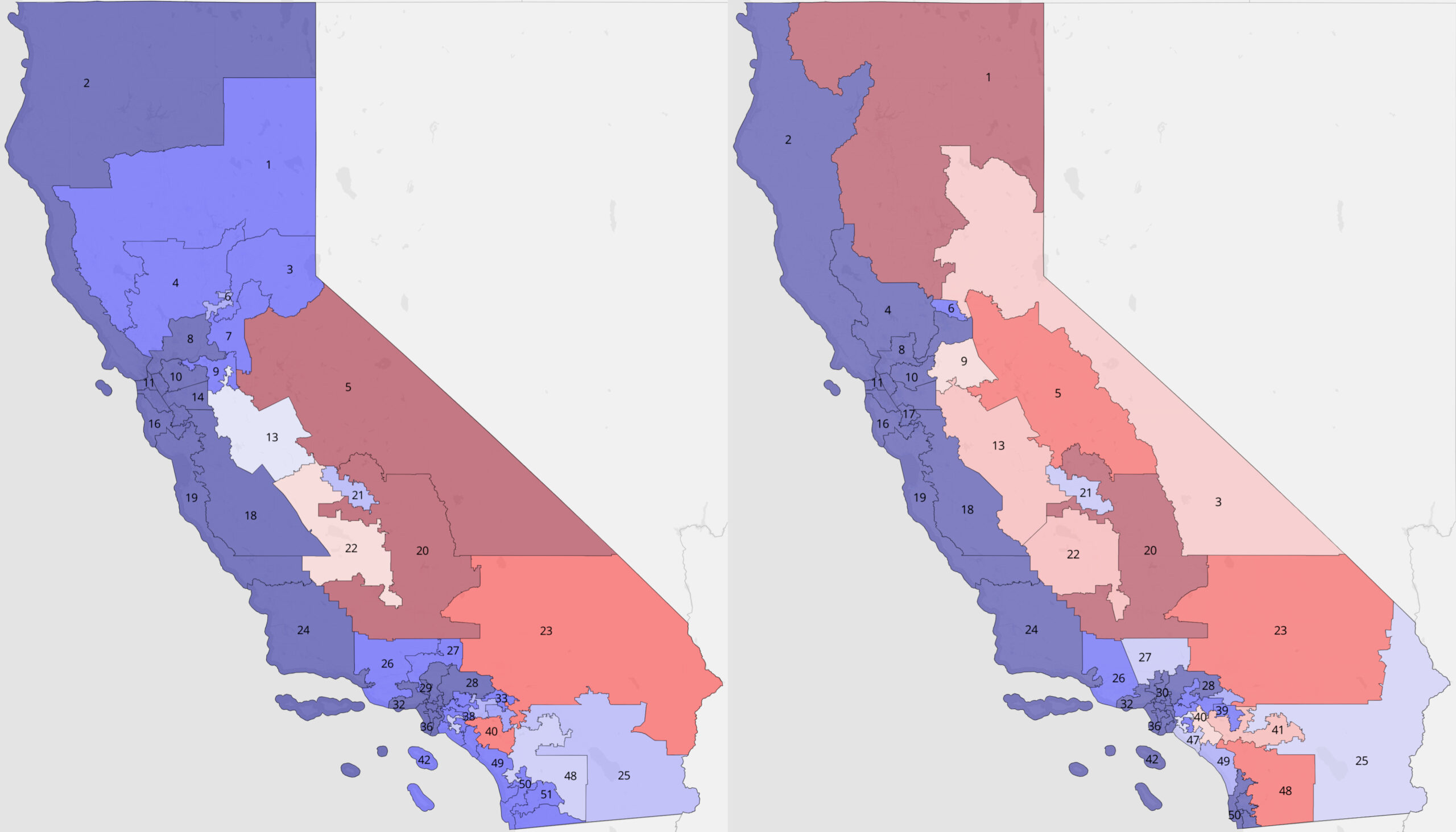By Jim Ellis — Wednesday, Aug. 27, 2025
Redistricting
Now that the new Texas redistricting map has been signed into law displaced Democratic incumbents and potential candidates are deciding where they will run.
In the Dallas area, a game of political musical chairs must be played. All three Texas Democrats who currently represent part of Dallas County no longer live in the district for which they will likely run.
It is probable that Rep. Jasmine Crockett (D-Dallas), whose home is now in Rep. Marc Veasey’s (D-Ft. Worth) 33rd District, will still run in District 30, where almost 69 percent of her current constituency resides. By the same token, Rep. Veasey’s best opportunity is in District 33, but he loses all of his Ft. Worth and Tarrant County base. Only 33 percent of his current constituency lies in the new District 33.
The Dallas Democrat with the least favorable choices is freshman Rep. Julie Johnson (D-Farmers Branch/Dallas). While 41 percent of her current constituency will reside in new District 32, that district now stretches into East Texas and becomes a Republican seat.
Almost one-third of her constituents move to District 33, but Rep. Johnson says she is looking at potentially challenging Republican Rep. Beth Van Duyne (R-Irving) in new District 24. Rep. Johnson sees only three percent of her current constituents landing in TX-24 but says a large portion of her former state House district is included. President Trump carried new CD-24 with a 57-41 percent margin, so Rep. Van Duyne, who finds 87 percent of her current district comprising the new 24th, remains in the driver’s seat for re-election.
Moving to Houston, veteran Rep. Al Green (D-Houston) says he is surveying the new 18th District as a place to run. He would be paired with the winner of the current special election to replace the late Rep. Sylvester Turner (D), but the latter individual will only have two months to organize a primary campaign against Green after winning the special election.
Rep. Green’s 9th CD transforms into an eastern Harris County Republican seat, while none of his district will move to CD-18. Much of the current Green constituency, almost 44 percent, goes to Rep. Sylvia Garcia’s (D-Houston) 29th District, of which Garcia would represent only 37 percent of the new CD. Still, Green would be well known in the 18th, and not having to face another entrenched incumbent should be a favorable setup for the 77-year-old House member who was first elected in 2004.
Looking at Austin, Rep. Lloyd Doggett (D-Austin) says he will not seek re-election rather than squaring off with fellow Democratic Rep. Greg Casar (D-Austin) in the new 37th CD. Mr. Doggett says he would seek re-election if the court restores the previous map.
In South Texas, Rep. Henry Cuellar (D-Laredo) sees a much different district, but one that he should like. Gone is the San Antonio portion of the current TX-28 seat where Cuellar experienced trouble in two close Democratic primary challenges. He is still under federal indictment with several charges for bribery, obviously a significant hurdle to overcome, while rumors still abound that he may switch parties. If he doesn’t, his likely opponent will be Webb County Judge (Executive) Tino Tijerina, who also hails from Cuellar’s home domain.
A major development affecting the South Texas seats occurred the other day when former Rep. Mayra Flores (R) indicated that she will move back to TX-34 to again challenge Rep. Vicente Gonzalez (D-McAllen) in a re-match of the 2024 campaign that saw Gonzalez prevailing 51-49 percent. Earlier in the year, Flores said she would challenge Rep. Cuellar in District 28.
In a new 34th that now contains almost 40 percent new territory for Gonzalez and all coming from Rep. Michael Cloud’s (R-Victoria) Republican 27th District, the partisan lean of the newly configured TX-34 will favor a strong GOP candidate.
A lawsuit challenging the new map as a racial gerrymander will quickly be filed in an attempt to void the new districts. This will likely put further pressure upon the Supreme Court to finally rule on the Louisiana racial gerrymandering case, which has now been scheduled for a second oral argument session on Oct. 15.
If the high court upholds the previous federal three judge panel ruling, then the Texas map will also likely stand and we would see re-draws forced in Louisiana and likely Alabama, which is in an identical situation to that of the Bayou State. In a related ruling, the 5th Circuit Court of Appeals upheld the Galveston County case that affected the Texas minority districts and was the reason Gov. Greg Abbott (R-TX) added redistricting to the legislative special session.
With the Lone Star State candidate filing deadline set for Dec. 9 in conjunction with the March 3, 2026, primary election, much will happen in the political and legal arenas during the next few weeks.





